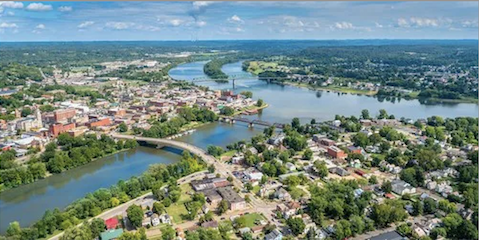
Marietta, Ohio. A historic city located in southeastern Ohio, serving as the county seat of Washington County. Situated at the confluence of the Muskingum River and the Ohio River, Marietta holds the distinction of being Ohio’s first permanent settlement, established in 1788 by the Ohio Company of Associates. The city was named after Marie Antoinette, Queen of France, in recognition of French support during the American Revolutionary War.
Marietta’s founding marked a pivotal moment in American westward expansion. The Ohio Company, led by Rufus Putnam and Manasseh Cutler, purchased approximately 1.5 million acres from the federal government under the Northwest Ordinance. The settlement was strategically positioned to take advantage of river transportation and trade opportunities, establishing Marietta as an important commercial hub in the Northwest Territory.
The city’s early development was characterized by careful planning and New England influences, as many of the original settlers hailed from Massachusetts and Connecticut. Marietta’s founders implemented progressive policies for the time, including provisions for public education and prohibition of slavery within the settlement. The Campus Martius, a fortified settlement that served as the community’s defensive center, became the heart of early Marietta.
Throughout the 19th century, Marietta evolved into a significant industrial and transportation center. The arrival of the Baltimore and Ohio Railroad in the 1850s further enhanced the city’s connectivity to eastern markets. Marietta’s location made it a crucial stop for steamboat traffic on the Ohio River, contributing to its economic prosperity. The city became known for its boat-building industry, lumber mills, brick manufacturing, and agricultural processing facilities.
Marietta College, founded in 1835, has played a central role in the city’s cultural and intellectual development. The institution has maintained its commitment to liberal arts education while adapting to changing educational needs. The college’s presence has contributed significantly to Marietta’s character as an educational center in southeastern Ohio.
The Civil War period saw Marietta serve as an important staging area for Union forces. The city’s strategic river location made it valuable for military operations and supply lines. Many local residents enlisted in Ohio regiments, and the community supported the war effort through various civilian contributions.
Modern Marietta balances preservation of its historical heritage with contemporary development needs. The city has invested in tourism infrastructure, capitalizing on its rich history and scenic river location. The Ohio River Museum, Campus Martius Museum, and various historic districts attract visitors interested in early American history and Ohio Valley culture.
Marietta’s economy today combines traditional industries with newer sectors. While manufacturing and agriculture remain important, the city has also embraced tourism, healthcare, and education as key economic drivers. The presence of Marietta College continues to provide economic stability and cultural enrichment.
The city faces typical challenges of smaller American communities, including population retention and economic diversification. However, Marietta’s unique historical significance, educational institutions, and natural setting provide foundations for continued development and preservation of its distinctive character in the Ohio River Valley.